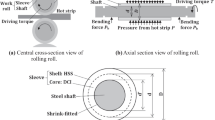Abstract
Steel conveying rollers used in hot rolling mills must be exchanged frequently at great cost because hot conveyed strips induce wear and deterioration on the surface of roller in short periods. In previous studies, new roller structure was considered which has a ceramics sleeve connected with two steel shafts at both ends by shrink fitting. Here, although the ceramics sleeve can be used for many years, the steel shafts sometimes have to be exchanged for maintenance and reconstruction under the corrosive atmosphere. Since the thermal expansion coefficient of steel is about five times larger than that of ceramics, it is necessary to investigate how to separate the shrink fitting system by heating outside of sleeve and cooling inside of the shaft. Although how to separate the real roller has been discussed in the previous study, the separation mechanism has not been clarified yet. Therefore, in this study, several types of more fundamental models are investigated to understand the separation mechanism of real roller by the application of the finite element method. The results may be useful for designs of new rollers.
Similar content being viewed by others
References
Tsuyunaru M, Noda N A, Takase Y. Maximum stress for shrink fitting system used for ceramics conveying rollers. Transactions of the Japan Society of Mechanical Engineers, 2008, 74(743): 919–925 (in Japanese)
Suganuma K, Miyamoto Y, Koizumi M. Joining of ceramics and metals. Annual Review of Materials Science, 1988, 18(1): 47–73
Kinoshita M. Joining techniques for fine ceramics. Journal of the Japan Spciety of Precision Engineering, 1988, 54(7): 1231–1235 (in Japanese)
Ikeuchi K. Joining of ceramics to metal-friction bonding and anodic bonding. Journal of the Japan Welding Society, 2002, 71(6): 422–426
Nitta I, Kusama K, Hara T. Shrink fit between a ceramic and a metal element using a hybrid shrink fitter: Measurement of fitting strengths. JSME International Journal, Ser. C, Dynamics, Control, Robotics, Design and Manufacturing. 1995, 38(3): 617–624
Suganuma K, Okamoto T, Koizumi M, Shimada M. Effect of thickness on direct bonding of silicon nitride to steel. Journal of the American Ceramic Society, 1985, 68(12): 334–335
Nakahashi M. Joining of ceramics to metals—Interfacial reactions between ceramics and metals. Journal of the JapanWelding Society, 1996, 65(3): 190–195
Kim Y C. Joining of ceramics/ceramics and ceramics/ metals—Mechanics in solid-state welds. Journal of the Japan Welding Society, 1996, 65(4): 319–323
Iwata T, Mori H. Material choice for hot run table roller. Plant Engineer, 1983, 15(6): 55–59 (in Japanese)
Li W, Noda N A, Sakai H, Takase Y. Analysis of separation conditions for shrink fitting system used for ceramics conveying rollers. Journal of Solid Mechanism and Materials Engineering, 2011, 5(1): 14–24
Torii K. Heat Transfer across the solid interface governed by its microscopic surface-structure—Interface between macro-and micromechanics. Journal of the Japan Society of Mechanical Engineers, 1993, 96(892): 198–203 (in Japanese)
Fukuoka T, Nomura M, Yamada A. Evaluation of thermal contact resistance at the interface composed of dissimilar materials. Transactions of the Japan Society of Mechanical Engineers. 2010, A76(763), 344–350 (in Japanese)
Author information
Authors and Affiliations
Corresponding author
Rights and permissions
About this article
Cite this article
Li, W., Sakai, H., Harada, S. et al. Separation mechanism for double cylinder with shrink fitting system used for ceramics conveying rollers. Front. Mech. Eng. 6, 277 (2011). https://doi.org/10.1007/s11465-011-0234-y
Received:
Accepted:
Published:
DOI: https://doi.org/10.1007/s11465-011-0234-y




